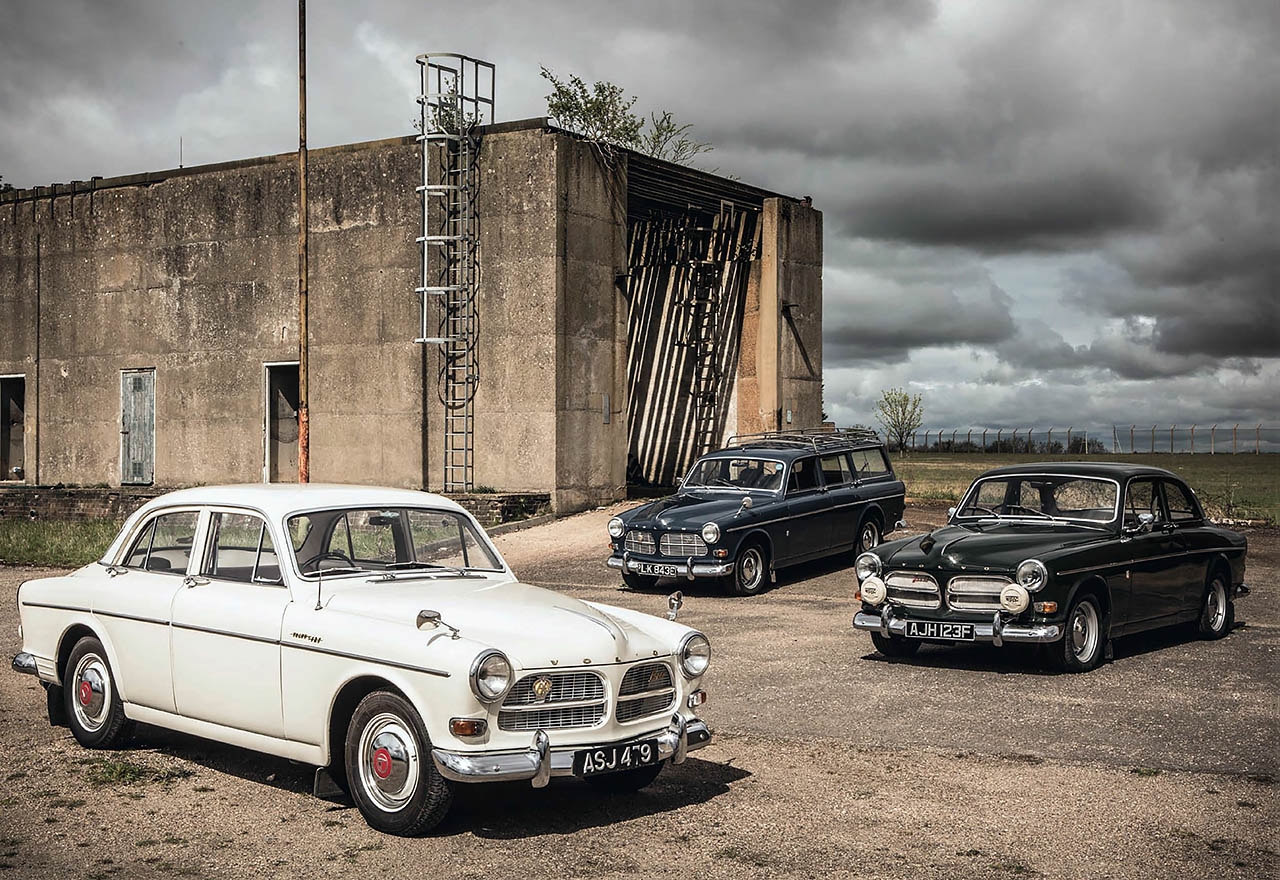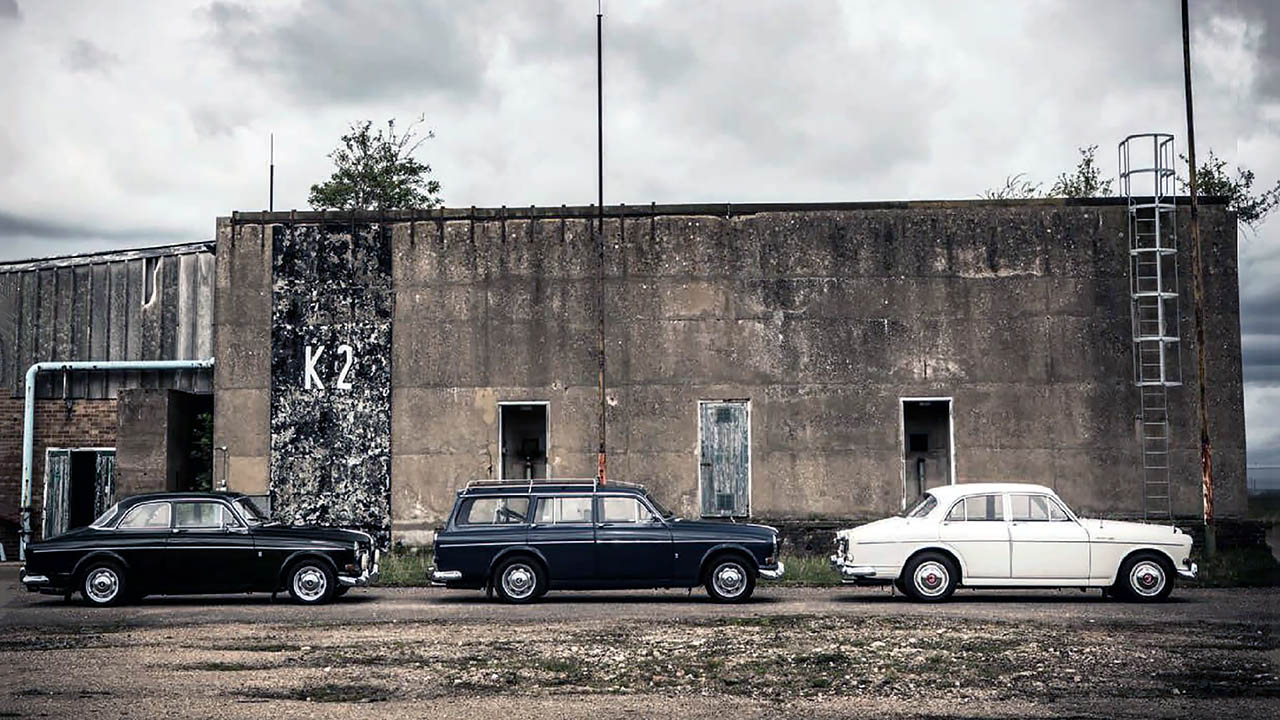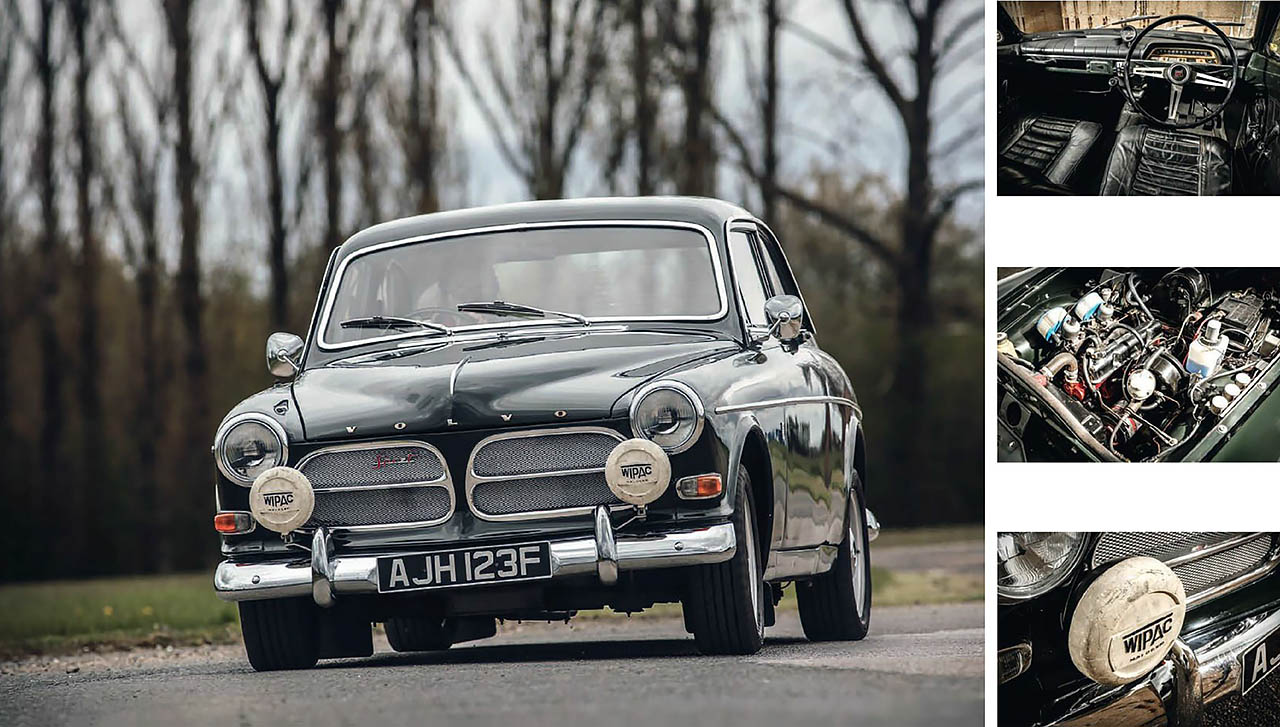
Faithful Friends Volvo Amazon at 60 Stylish Swedish trio celebrated. Marking a milestone in the life of Volvo’s practical, stylish Amazon. Andrew Roberts investigates the enduring appeal of Volvo’s wonderful Amazon range, which celebrates its diamond jubilee this year. Photography Tony Baker.
The Swedish have a term vackrare vardagsvara, which translates roughly as the demand for ‘beauty in everyday items’. For a motor manufacturer, the balance between aesthetics and practicality can be challenging to achieve but the Volvo Amazon is one of the most successful examples. Our windswept setting could be a backdrop for a Bergman film or one of those Nordic crime dramas in which the inspector downs aquavit before piecing together the evidence, but this car is at home in virtually any setting – even 60 years after its launch.
Volvos are now street furniture in the UK so it takes a considerable leap of imagination to consider that, when the Amazon starred at the 1956 Earls Court Motor Show, there were thousands of motorists who had never heard of the marque. Official sales commenced two years later and the 120 range became the first Swedish car seen in suburbia because Saabs were not available here until 1960. One early tester was racing driver Mike Hawthorn, who reviewed a 122S for the Sunday Express and found its finish to be ‘as splendid as the Midnight Sun’ and the suspension ‘not too hard for rich and fragile aunts’.
To the uninitiated, the Amazon line-up is almost as confusing as that of the Citroën DS range, with numbers such as 121 (a basic fourdoor), 131 (the equivalent two-door) and 222 (a more powerful estate) confusing if logical.

Westcott doubles as the setting for a Scandinavian drama. Right, from top: strip speedometer was a constant in roomy cabin; Volvo corners safely, with little body roll; S models featured twin-carb engine.
Aficionados can instantly recognise a particular member of the line-up via the grille pattern or hubcaps, but for now we will merely state that the original model was called the 120 and it was announced on 1 August 1956. Volvo had planned to badge its new car as the Amazon, but, following complaints from the German motorcycle maker Kreidler, this was used only on the home market. The 1.6-litre engine and three-speed transmission were familiar from the PV444, but the four-door coachwork was a sensation.
One major inspiration for designer Jan Wilsgaard (see panel) was a Kaiser that he had seen at Gothenburg harbour, although he was obliged to undertake the development of the new model in his own free time because management forbade work on such a frivolous-looking car during office hours. MD Assar Gabrielsson was of the opinion that a Volvo should look discreet and bemoaned Wilsgaard’s creation as having ‘too much of the pin-up about it’.
And the 120 was indeed the Anita Ekberg of the car world to a Swedish buyer of six decades ago. Its quasi-Detroit lines were no surprise because American cars were a familiar sight on Swedish roads at that time and the PV444 resembled a 1941 Ford. The Amazon appeared contemporary, though – it was the first Volvo with a duotone paint finish – without being too flamboyant for a Stockholm assistant bank manager. The 120-series did not immediately replace the PV range, which remained in production until ’65 and was gradually phased out as the Amazon line-up expanded. Deliveries commenced in March 1957, followed by the introduction of the twin-carburettor S the following year and, to the relief of Volvo’s customers, the option of a four-speed gearbox. In 1961, the 1.6-litre engine was phased out in favour of the 1778cc B18, which was a slightly modified version of the P1800’s unit.
The oldest of our trio is a 122S B18, which combined the larger engine with twin SUs and a rather dashing appearance. To a 1963 driver, the Volvo’s transatlantic lines would not have been exceptional in themselves – its near contemporary, the Humber Hawk, followed Detroit styling tropes – but what remains notable is how Wilsgaard never fell into the trap of American pastiche such as the Vauxhall Victor F-type or the Ford Consul-Classic. The Amazon’s lines were intended to appeal to US and Canadian buyers, although not in a way that would render the bodywork as hopelessly old hat within just a few years. From today’s perspective, every aspect of the 122S is well balanced, from the Chrysler 300-style front grille to the vestigial tailfins. It is certainly an old car, but never a dated one.

The same air of practical refinement pervades a cabin that is businesslike but not spartan. A 122S with the optional Laycock de Normanville overdrive cost £1399, so it competed against the likes of the Wolseley 6/110, where a buyer might expect walnut veneer and hide trim. Inside, the 122S has well-fitted rubber mats, three-point static front seatbelts (standard on all Volvos since ’59), a universally jointed steering column and a heater with a volcanic output. This last item proved to be of particular use on a spring day when sleet threatened. The front seat backrests have a choice of three positions and most drivers opt for ‘commanding’; an Amazon is that type of car. A row of identical switches provides entertaining confusion for the novice; I attempt to operate the heater fan with the cigarette lighter.
To an Ian Hendry-style young executive, the 122S with thick ’screen pillars and long gearlever sprouting directly from the toe-board may have seemed staid compared with one of those new Rover 2000s, yet many saw the Amazon as a car of quiet distinction. After all, a Volvo had won that year’s European Rally Championship and it was ideal for reaching that breakfast meeting at Farthing Corner on the M2 in record time.
Hawthorn found the gearchange to be ‘as stiff as the noblest upper lip’ but the stout lever proves to be delightfully precise. Once on the move, the steering seems quite light for a substantial motor car and, although the 122S feels heavy at low speeds, it is a fine touring vehicle. The orange needle careers across the strip speedo with aplomb, in fact. One bonus not found on earlier models is front disc brakes, but the pedals are not entirely suited to size-12 brogues.
American-market 120s were sold as ‘the distinguished car for distinguished people’, with pictures of well-heeled types beaming at their Volvo while playing a round of golf or merely looking disdainfully at any Corvair owner in their midst. The last half of that claim may be pure Madison Avenue snobbery but the first part is a fair statement. Any 1963-vintage British motorists would have regarded the 122S as affordably exotic. Even after the inflation of the price by Purchase Tax and import duties, the Volvo was cheaper than a Mercedes-Benz 190C and it conveyed a sense of panache to a go-ahead accountant or progressive-minded solicitor.
For the driver who found the Triumph 2000 too youthful, the Hawk too municipal and the Cresta PB too ‘wideboy made good’, the Amazon alternatives were the slower but equally wellbuilt Peugeot 404 or maybe the Gaz-Volga M21, a few of which found homes in the UK. Volvo ownership was less likely to have the neighbours thinking you were a KGB sleeper agent, however.
A two-door Amazon was added in ’61 and the following year the range was expanded with a station wagon, the car that Britain’s antique dealers had desired for so long. Before 1962, the standard Volvo estate was the PV445 Duett, which for the previous nine years had established a niche as Sweden’s national workhorse. The firm intended the five-door Amazon to appeal to a rather different market, however. The development costs were considerable – the roof, rear doors, wings and tailgate were unique to the 221 – and the new model was aimed at the upper middle classes. Both cars remained in production until ’69, when they were replaced by the 145.

Clockwise: versatile and rugged estate is really comfortable, with lumbar adjustment to front seats; rear numberplate hinges to reveal fuel filler; there’s lots of luggage space, even without folding rear seats.
When looking at our redoubtable 1966 model, it is hard to envisage how any Volvo could cause controversy. In 1965, this proved to be the case when Hampshire Constabulary ordered an Amazon estate – the first foreign car bought by the British police. This blue example was originally registered to a British serviceman in West Germany, probably gaining a UK plate in 1967. The badging states that this is a 121, although it was officially known as the 221, but semantics are of less interest than the detailing. The device behind the driver’s headrest (itself rare in a car of this era) is not a TV aerial but a coat hanger. Plus, the front seats have lumbar support adjusters, the rear numberplate is hinged à la early Mini, and the rear overriders double as steps.
Concerning performance, the 221’s singlecarb engine is not quite as lively as the 122S, but it would still have caused MG 1100 owners to gawp in amazement at traffic lights. More remarkable still are the road manners, which would have been a revelation to any motorist used to the Ford Zodiac MkIV Farnham or Super Snipe station wagon. To Volvo, an estate car could be practical without handling like the Queen Mary and be equally at home in a farmyard as in the directors’ car park. Despite the artificial raising of the Amazon’s UK price, it was still competitive. At £1420 in ’68, it cost 200 quid more than the equivalent Corsair V4 but undercut a Triumph 2000 estate – one of its closest rivals – by £120.
The final member of our group is the 123GT, a car that belongs to a distinct category of 1960s sports saloons. It made its debut in 1967, a time when not a few drivers were prone to decorating their Mk2 Cortinas with leopard-skin steeringwheel covers and ‘performance’ rims. They would then don imitation-leather driving gloves for a trip to Victor Value, happily immune to work colleagues laughing at the idea of how a highly decorated 1300 De Luxe could hope to transform its owner into the next Jackie Stewart.
Our Cortina owner would have considered the idea of an Amazon sports saloon as bizarre as Tommy Steele joining Cream. Yet, to those who valued discretion and quality – and had little time for check wiper blades and other such frivolities – the 123GT was the ideal Volvo. Under the stout bonnet lurked the P1800’s 1.8 engine and overdrive was standard. There were various racy accoutrements – competition dampers, a threespoke steering wheel, auxiliary lamps and a Smiths tachometer – although these were all in keeping with the 120’s practical philosophy.
The result is an innocuous-looking two-door saloon (there was no four-door) that appeared as if it hailed from the 1950s and drove like a car two decades younger. Our ’68 example has the 2-litre B20 unit as fitted to the 1800S, plus optional hide trim and wider wheels with banded steel rims. The 123GT ranks alongside the MG Magnette ZA and the Borgward Isabella as a great post-war Q-car that can accelerate past startled-looking Vauxhall Astra owners with élan.
‘Drive it like you hate it’ suggested Volvo’s advertisements, but that would be impossible in a car of such a good nature. Boy-racers may enjoy dramatic cornering, although the 123GT just modestly leans over and performs the manoeuvre with well-bred understatement. The main noise is from the vast exhaust, which looks as if it belongs on a modern hot hatch. Yet the raison d’être of this splendid motor car is that efficiency was not incompatible with sheer fun.
Amazon production finally ceased on 3 July 1970, by which time the Volvo name was established across the globe. Assar Gabrielsson may have believed that it was better for ‘a car to be ugly rather than too beautiful’, but the 120 series continues to prove the fallacy of that argument – vackrare vardagsvara indeed. Or, in the inimitable words of Mike Hawthorn, an Amazon is ‘a sensation of a car’.
‘TO VOLVO, AN ESTATE COULD BE EQUALLY AT HOME ON A FARM OR A DIRECTORS’ CAR PARK’

Front end has a hint of Chrysler 300 – mesh grille on this car similar to early Amazon. Below, l-r: rev counter sprouts from dash in sporty 123GT; Wipacs emphasise the image; twin SUs on this 2-litre engine.
Thanks to owners Kevin Diamond (122S), Mark Whitton (221), Gillian Whitton (123GT); Adrian Fell, AJF Motor Engineers; everyone at Westcott Venture Park: www.westcottventurepark.com; Volvo EC: www.volvoenthusiastsclub.co.uk
‘THE IDEA OF A VOLVO SPORTS SALOON SEEMS AS BIZARRE AS TOMMY STEELE JOINING CREAM’
Sculpture student turned car stylist
It took time for Jans Wilsgaard to convince the old guard at Volvo about his fresh approach to car styling. He was studying sculpture at art school when, in 1950, he decided to jump ship – with a year of the course remaining – and take a job with the car maker. His fledgling in-house department was often in competition with external design houses. In fact, the youngster’s first three proposals – the Philip (1950), the PV179 (’52) and the 55 a year later – did not make it to fruition.
Things changed with the universally acclaimed Amazon, though, even if his then MD thought it was a bit racy for the sober marque. Wilsgaard set the Volvo template for the 1970s and ’80s, with the boxy-but-elegant and durable 144, 164 and 200 series, plus the 700 range.
The final model that Wilsgaard had a hand in was the 850. It marked the end of the cubist line before Peter Horbury smoothed off the edges, ruffling the feathers of Volvo’s conservative customers rather than the firm’s top brass.
‘THE LINES FOLLOWED DETROIT TROPES, BUT NEVER VENTURED INTO AMERICAN PASTICHE’
TECHNICAL DATA VOLVO AMAZON 122S
Sold/number built 1958-1967/234,209 (all four-door Amazons)
Construction steel monocoque
Engine all-iron, overhead-valve 1778cc ‘four’, with twin SU carburettors
Max power 90bhp @ 5000rpm
Max torque 105lb ft @ 3500rpm
Transmission four-speed manual, driving rear wheels
Suspension: front independent, by double wishbones, anti-roll bar rear live axle, torque arms, Panhard rod; coil springs, telescopic dampers f/r
Steering cam and roller, 3 ½ turns lock-to-lock
Brakes discs front, drums rear, with servo from 1964
Length 14ft 7in (4450mm)
Width 5ft 4in (1626mm)
Height 4ft 11in (1499mm)
Wheelbase 8ft 6 ½ in (2604mm)
Weight 2403lb (1090kg)
0-60mph 14.4 secs
Top speed 94mph
Mpg 24-30
Price new £1399
Price now £5000
221 Where different to 122S
Sold/number built 1962-1969/73,196 (all Amazon estates)
Engine single Zenith carburettor
Max power 75/85bhp @ 4500rpm
Max torque 101lb ft @ 2800rpm
Height 5ft 1 ¼ in (1556mm)
Weight 2645lb (1200kg)
0-60mph 17.6 secs
Top speed 90mph
Price new £1420 (220, 1968)
Price now £8000
123GT Where different to 122S
Sold/number built 1966-1968/359,917 (all two-door Amazons)
Engine 1778/1986cc, twin SU carburettors
Max power 115bhp @ 6000rpm
Max torque 112lb ft @ 4000rpm
Transmission four-speed manual, plus overdrive
Weight 2535lb (1150kg)
0-60mph 11.2 secs
Top speed 109mph
Price new n/a
Price now £20,000





